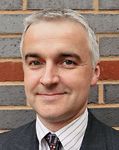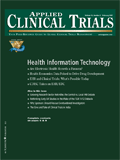India: Give or Take?
Applied Clinical Trials
With its vast pool of patients and well-trained, English-speaking investigators, what exists to take advantage of in this research-rich country is clear. What needs to be given back, however, is not so clear. Despite the uncertainty, one thing seems evident: Responsibility is key to giving back.
Through the commercial lens of a business with shareholder returns to address, the age-old adage "It's better to give than to receive" may sometimes be difficult to enact in its purest sense. It may, nonetheless, be worthwhile to evaluate the appropriateness of this saying in the context of the rapidly growing clinical trials environment in India. Indeed, those seeking to make their mark may well wish to contemplate the perception—seldom-voiced though it may be—that the new kids on the block have come simply to exploit the trial advantages that India has to offer.

Nigel Page
These advantages have been extensively documented and generally mention India's large treatment-naïve patient population; well-trained clinical professionals; an increasingly capable, quality-oriented research environment; and the cost advantages associated with the geography. Coupled with the advantages, however, come responsibilities for those engaged in the conduct of clinical trials.
Answering the call
It is true that India has a vast pool of genetically diverse patients. It remains a key responsibility of state and regulator alike to ensure that sufficient protection and consideration have been given to the ethical concerns surrounding this population. Without this, the critical voices of exploitation will be allowed free rein to the detriment of industry and, indeed, the very patients whose access to new medicines is compromised by those who allege to be protecting their rights. Encouragingly, government initiatives aimed at strengthening ethics committees, ethical guidelines, and independent review boards stand to provide the required levels of protection.
Ready access to well-trained, English-speaking investigators has been another oft-cited India advantage and the clinical development world has increasingly sought out these professionals. But the investigator is not an island alone and only can perform clinical trial activities successfully within the supporting infrastructure of other health care professionals, facilities, and technology. Earlier concerns relating to the integrity of data and its acceptability as part of global submissions have been allayed due to the increased availability of Good Clinical Practice–trained staff. But industry still has a viable role to play in continuing to promote best practices in training, resourcing, and the role definition of those engaged in clinical research.
Infrastructure also extends to the development of a robust and adequately staffed centralized regulatory agency capable of keeping pace with the demands placed upon it: increased volume, the inevitable demands of the "new" (clinical research is still a relatively recent industry), and the specific demands of India.
A balancing act
What exists to take advantage of (without exploitation) is clear; what needs to be given is less clear. It is not talent—India has an abundance of that, including those temporarily absent citizens who went abroad for education and training. It is obviously not local knowledge—India understands its own complexity and uniqueness perfectly well without outside help. It is not charity—for in isolation this merely perpetuates the erroneous view that India cannot work through its own trials and tribulations.
Striking the right balance between give and take may well be difficult to achieve. This is especially true for the inward investor in India, and increasingly so as the interest in conducting trials in India has the potential to outrun the country's ability to service the short-term need. But it is a long-term view that must be taken in terms of job creation, helping to improve the local medical and academic system, training, developing, and promoting "homegrown" Indian talent through the ranks in global companies.
In all likelihood, it may be the very growth of global clinical research itself which constitutes the give: study participants enjoying the benefits of improved health care through drug and device innovation; the health care infrastructure reaping the benefits that flow from trial investment; and health care professionals benefiting from the acquisition of scientific and medical knowledge without a need to leave their homeland. Perhaps the contemplation of our adage will suggest a state of coexistence: that it is better to give and to receive.

Improving Relationships and Diversifying the Site Selection Process
April 17th 2025In this episode of the Applied Clinical Trials Podcast, Liz Beatty, co-founder and chief strategy officer, Inato, discusses a number of topics around site engagement including community-based sites, the role of technology in improving site/sponsor relationships, how increased operational costs are impacting the industry, and more.